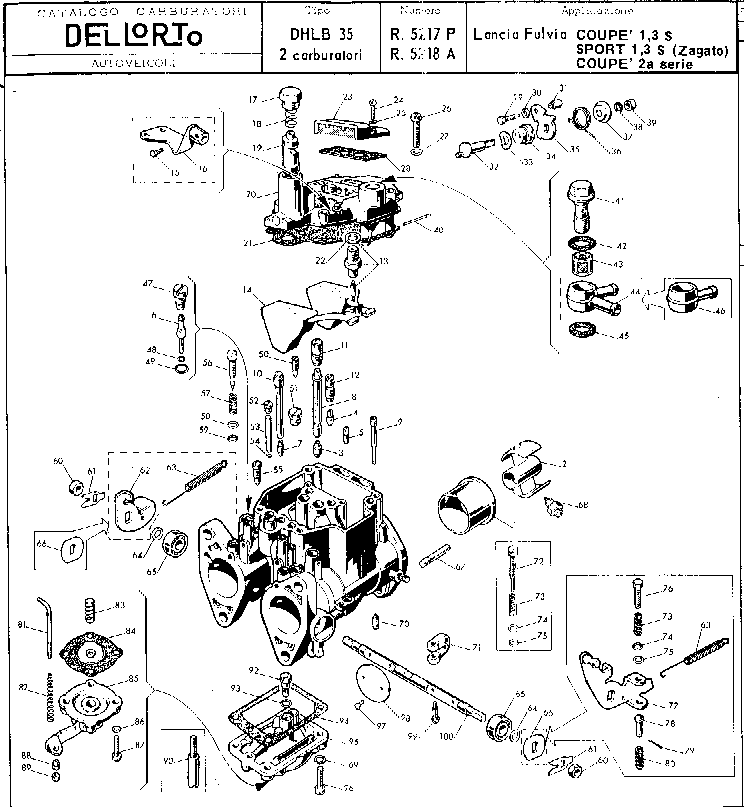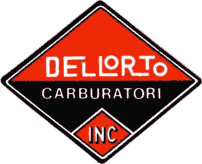
|
DIRECTIONS FOR ADJUSTING AND BALANCING PAIRS OF DELLORTO DHLA AND DHLB CARBURETORS
Requirements: a long screwdriver , possibly a short length of plastic or rubber hose, up to twenty minutes although this is something better done if not hurried.
- Where the carburetors have had considerable use, apart from first checking and, if necessary adjusting the individual carburetor float-levels, it is usually worthwhile to remove each idle-mixture adjustment screw 56, cleaning and polishing it before replacement. This should then make each one more sensitive when responding to slight adjustments. Take care not to misplace the O-rings and washers under the screw springs.
- Warm up the engine by running at 1200-1500 rpm for about five minutes with the carburetors fitted but unadjusted except for the idle speed using the idle speed screw. In subsequent readjustment, the engine would be better to be fully warm, as after a good run, but do bear in mind that in the winter the engine does not get nearly so hot as during the summer, so readjustment to coincide with seasonal changes will usually be worthwhile.
- Switch off the engine and, with a finger, try to close the right carburetor throttles completely by pressing the right balance-lever assembly 62 firmly against its stop. This may not be fully possible because of the position of the adjusting-screw 76 and the main-lever tongue, but usually the left carburetor throttles will now be slightly open. Now readjust the carburetor balance by screwing or unscrewing the balance-adjusting screw 76 until the left main-throttle lever can be seen to just close the left carburetor throttle-butterflies completely. Check they are fully closed by pulling upwards on the extension on the main-lever which usually touches the idle-speed screw.
- This should be the desired synchronised position but, as it is difficult to be sure both carburetors throttles are fully closed at this point, continue slowly screwing the balance-screw 76 in and you should now see the right lever opening while the left one is pressed shut. By then screwing back again, it is possible to judge more accurately the point where the left lever has stopped closing and the right lever has not yet started to open. Alternately, listening through the tubing inside each carburetor choke in turn with the engine idling slowly, adjusting screw 76 until each cylinder sounds as similar as possible, should produce effectively virtually the same result
- Now screw the idle-speed screw back into contact with the lever 77 and then in two to three more complete turns.
- Disconnect the front two spark-plug leads and restart the engine to run on the rear two cylinders only. The idle speed should be steady and as far below 1000rpm as possible without risk of stalling. Now adjust the two idle-mixture screws 56 on the rear carburetor to obtain the fastest even running. This adjustment is very sensitive as the two firing cylinders have to overcome the drag of the other two. If the idle-mixture of one of these two working cylinders is adjusted much away from its optimum setting the engine will respond by noticeably slowing down, vibrating badly or stalling. Do try, however, not to waste time here to reduce the risk of the non-working spark-plugs fouling or wetting.
- Stop the engine and repeat the procedure with the rear plugs disconnected. Different final positions of each pair of mixture screws often indicate incorrect float-levels of one or both carburetors; check if in any doubt and carefully readjust.
- Now connect all four plugs, set the idle to normal speed and, using the fingers, blip the throttle quickly several times. If the engine does not pick up cleanly but vibrates, hesitates or shakes, readjust the balance-screw slightly while blipping the throttle until the best position is found. In this position, both pairs of carburetor throttle- butterflies should be opening together from the same slightly-open idle position. If a wildish camshaft, overlarge carburetor chokes, unsuitable jets, spark-plugs or ignition timing, etc, are used, this optimum setting my not be perfect or even acceptable, but at least the throttles are properly synchronised with the best idle-mixture and idle-speed settings attainable.
- This is all that should need adjusting to set up the carburetor assembly but some further overall improvement can often be made by adjusting the ignition-timing slightly afterwards and perhaps then readjusting the mixture screws. Also, with a new pair of carburetors, or even with just new jets, it does take a few hours of running before the petrol properly wets the machined surfaces. Until then, surface tension makes most of the calibrated sizes much smaller in practice, so, for optimum performance, the whole procedure should really be repeated later on, say after five hours running. Don't jump to wrong conclusions about jetting too soon! Dellorto carburetors have finely calibrated jets and internal parts, needle-like idle mixture-screws and a remote idle-speed screw, so what might seem a rather long adjustment procedure should be amply repaid by excellent running and everything staying in tune for longer than the normal service intervals.
Performance with economy and reliability too!
|




